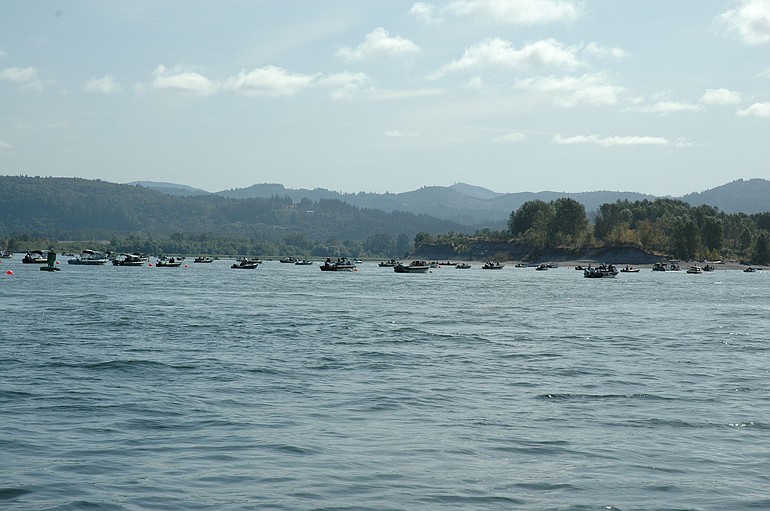LONGVIEW — By the hundreds, the boats are anchored in the deep water of the Columbia River here, one of the better spots to catch fall chinook salmon.
The hoglines extend downstream to below the bridge connecting Longview and Rainier, Ore.
Yet guide Jim Nicol of Newberg, Ore., says anglers are missing a good bet if they don’t try fishing in Carrolls Channel, the portion of the Columbia River between the Washington shore and Cottonwood Island.
The Cowlitz River joins the Columbia in Carrolls Channel, dumping in a substantial amount of cooler water that steelhead, chinook and coho seek.
Nicol said he’ll guide in the vicinity of the Cowlitz River mouth until mid-October.
The Cowlitz is a major coho producer offering opportunity after chinook retention downstream of Woodland ends on Sept. 11.
Nicol said he only fishes the deep water a day of two a season in the Rainier-Longview area.
“Most of the time I’m in 14 feet, fishing all spinners,’’ he said at a Portland seminar. “The water is clear enough and I think the spinners are better than the Alvins (a brand of wobbler). I like the action of a spinner.’’
It is all about finding the correct water temperature when fishing in Carrolls Channel or other tributary mouths, he said.
“You want to find that 60- to 63-degree water,’’ Nicol said. “Water temperature is everything. Depth means nothing. Location means nothing.
“If you’re in 57-degree water, you probably won’t get a hit. The 60- to 63-degree water is perfect to catch chinook and coho in the tributary mouths. Scout it out. Find where that water is.’’
But finding, and keeping, that 60 to 63 degrees, is a juggling act, as the tidal cycle, flow from the Cowlitz River and flow of the Columbia are a constantly changing dynamic.
“You can anchor at the mouth of the Cowlitz in 60 degrees, then three hours later as the tide is outgoing you are in 56 or 57 degrees,’’ he said. “Just because you start in 60 degrees, don’t think it’s going to stay 60 degrees all day. Be prepared to pull anchor and move to get back out. If you start at 60 degrees, you’re going to catch fish. If it goes to 57, you’re not.’’
While there will be hundreds of boats anchored in the Rainier-Longview area on the outgoing tide, most go home when the incoming tide stops the current from working their gear.
But the incoming tide is a great time to troll in Carrolls Slough, Nicol said. The fish are still there and the most of the anglers are gone.
“Always troll on the flood (tide),’’ he said. “I’ll stay trolling on the ebb if I don’t get so many anchor lines I can’t troll effectively.’’
Nicol said the key to trolling is to stay close to the bottom (within 6 to 8 inches) and to use a rod with a tip where the steady rotation of the spinner blade can be monitored.
“Pay attention to your rod tip,’’ he said. “If you’re trolling, and your rod is too stiff, you’ll troll too fast.’’
He uses 5 to 7 feet of leader, but says the precise length is not critical.
If anchored, and the river is running harder and harder, necessitating 3 to 5 ounces of lead in Carrolls Channel, the spinner blade will rotate too fast, sending out a lighter vibration instead of the thump found at lower speeds.
“Because the current is picking up, it’s creating lift on your spinner and getting your gear up a little too high,’’ Nicol said. “There’s one of two things you need to do: shorten the lead line a foot, that’ll lower your spinner. The second thing: Shorten up your leader a foot.’’
Nicols said while most anglers in the Rainier-Longview area anchor in the deep water, or in Carrolls Slough downstream from the mouth of the Cowlitz, don’t be afraid to explore new water.
“Up until three years ago, we never fished up above the entrance of the Cowlitz,’’ he said.
“We’re finding on the big incoming tides, especially, it’s taking that cold water and pushing it all the way up through Carrolls Channel, all the way to where it comes back into the main entrance near Kalama.
“You’ll find 60-degree water on a huge incoming, and you will catch these fish all the way up channel.
“I’m guessing it’s probably 6 miles…There are spots were it’s 30-35 feet deep.’’




